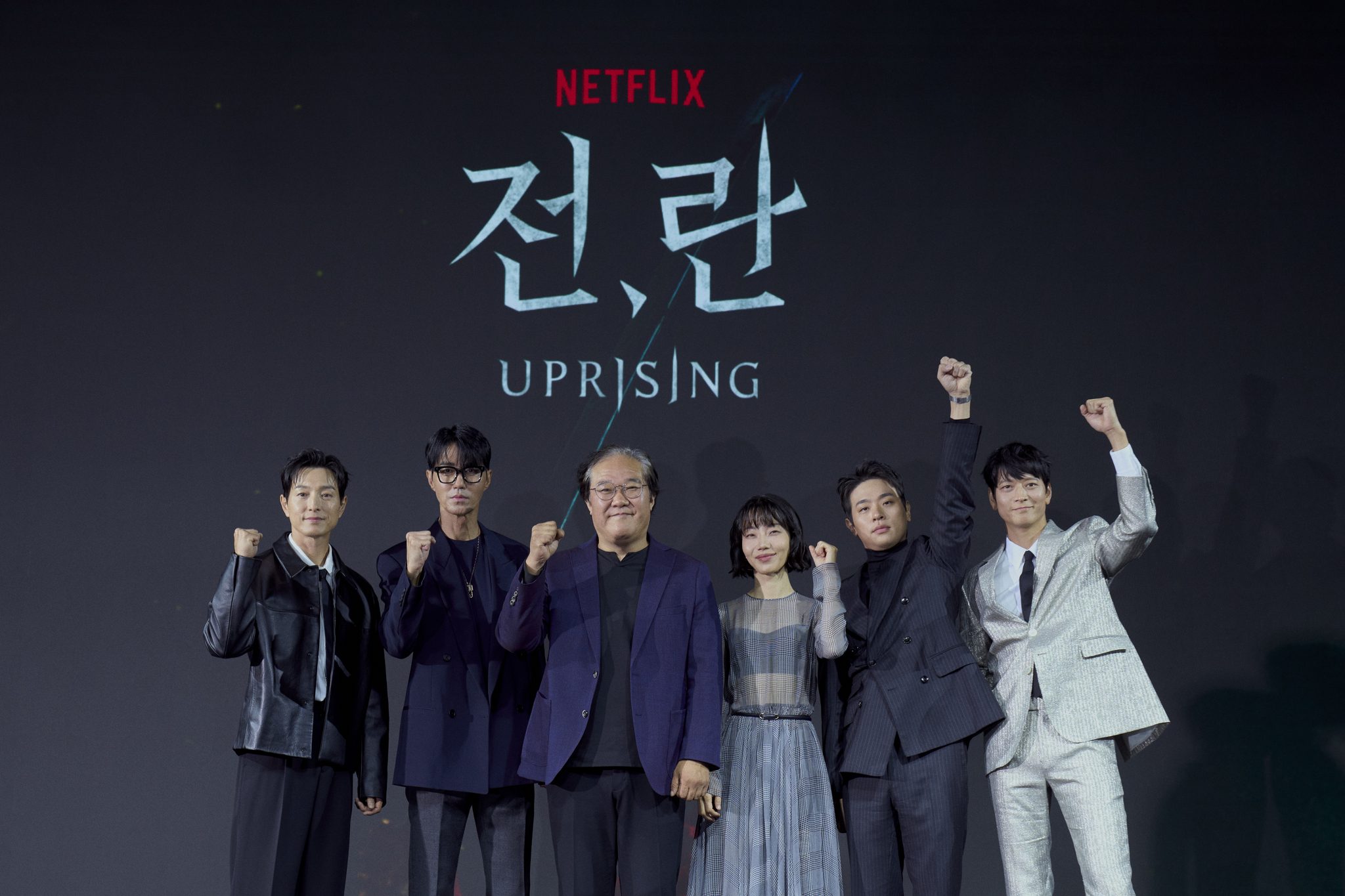
Park added, “When I told a friend that Gang would appear in the film as [my slave], they dismissed the idea, saying, ‘Gang would never do that.’ Many others questioned me as well, and I thought that with this level of attention, the film would definitely become a hot topic.”
Directed by Kim Sang-man and produced by director Park Chan-wook, the historical film revolves around two childhood friends — the son of a renowned Joseon warrior, and a slave — whose differing social standings lead them to become adversaries during the Joseon Dynasty (1392-1910).
![Still from Netflix historical film ″Uprising″ [NETFLIX]](https://koreajoongangdaily.joins.com/data/photo/2024/10/11/f4d1cde6-cc2d-46e8-bcc3-4870a677cc3e.jpg)
The film, set for release on Friday, was recently selected as the opening film for the 29th Busan International Film Festival (BIFF), which was a rare first.
The historical piece features a star-studded lineup of actors, including Gang and Park, as well as Cha Seung-won, Jung Sung-il, Kim Shin-rock and Jin Sun-kyu.
In the film, Park portrays Lee Jong-ryeo, a son from a prestigious military family during the Joseon Dynasty, while Gang plays Cheon-yeong, a slave of Jong-ryeo’s family who displays exceptional swordsmanship.
Gang revealed that it was his first time being offered to play a slave. He also said that he personally felt happy to receive such an offer. The actor often played commanding roles, such as a nobleman or a warrior, as shown in his previous historical pieces like “Duelist” (2005) and “Kundo: Age of the Rampant” (2014).
![Still from Netflix historical film ″Uprising″ [NETFLIX]](https://koreajoongangdaily.joins.com/data/photo/2024/10/11/a1bc891d-5bd3-4378-a92d-e8e516a86936.jpg)
“I had the confidence to portray the role of a slave well. And in fact, for me, I actually feel rather uncomfortable when playing an aristocrat,” Gang said.
For Cha, who portrays King Seonjo (r. 1567-1608), his challenge was to differentiate his portrayal from the many other depictions of this frequently represented character on screen.
“My biggest concern was finding the right balance for a precarious and unpleasant character who appears just when you think he’s gone, creating danger for others and causing trouble again,” Cha said.
The actor also put a lot of thought into the physical portrayal of the king, such as the shape of his beard and wrinkles, and he even lost weight, saying, “I prepared a lot to portray a more cynical appearance.”
![Still from Netflix historical film ″Uprising″ [NETFLIX]](https://koreajoongangdaily.joins.com/data/photo/2024/10/11/cfbc6674-c418-4af5-b144-7155afd84661.jpg)
![Still from Netflix historical film ″Uprising″ [NETFLIX]](https://koreajoongangdaily.joins.com/data/photo/2024/10/11/334bddcc-69bf-4735-9c8d-105b5e21eccd.jpg)
The film’s script showed a significant difference from others, which drove Gang to participate in the film.
“The script had certain differences from typical film scripts, particularly in the character dynamics and the depth of each character’s story,” Gang said. “Generally, films often focus on the main character due to time constraints, but this film effectively highlights each individual’s story, which I found appealing.”
Although the film features characters from various social classes, the director aimed to convey a message beyond the social status conflict, focusing instead on the diverse perspectives surrounding a single event.
![Actor Gang Dong-won speaks during a press conference for Netflix film ″Uprising″ held in Dongdaemun District, eastern Seoul, on Thursday. [YONHAP]](https://koreajoongangdaily.joins.com/data/photo/2024/10/11/767ad24a-b191-41a3-9b61-bd0782073cf1.jpg)
“The film is more than just simply a conflict between social classes. I believe that people perceive the world through a lens based on their position in society, which was something I wanted to fully capture because the film’s script thoroughly incorporated the diverse perspectives among the people,” director Kim said.
The director also revealed that he wanted to capture a specific scene during the film production: the landscape of Gwanghwamun, which is located in the center of Seoul.
“I tried to show a contrast between the prosperous and joyful street before the Imjin War broke out and the tragically transformed landscape after the war,” the director said. “In order to capture [the tragic scene] as if it were a scene from a post-apocalyptic film, we built a massive set.”
The cast encouraged viewers to look forward to the details and mise-en-scène of the film alongside its main storyline.
![Still from Netflix historical film ″Uprising″ [NETFLIX]](https://koreajoongangdaily.joins.com/data/photo/2024/10/11/ccb55cee-6503-46cf-b67b-7f6ef5c7217b.jpg)
“There are many metaphorical elements, such as the props and costumes,” Park said. “When focusing on these details, I think I was able to feel the characters’ emotions more deeply and got interested in them even more. So, I believe that if the audience pays close attention to these aspects, they will find the film even more enjoyable.”
Also, Kim Shin-rock added, “The film captures the truly beautiful landscapes of Korea, as we explored various filming locations. So, I think that the film will provide the viewers with the enjoyment of seeing the beautiful sceneries and mise-en-scène.”




